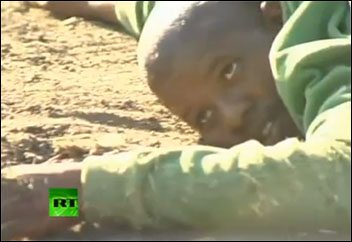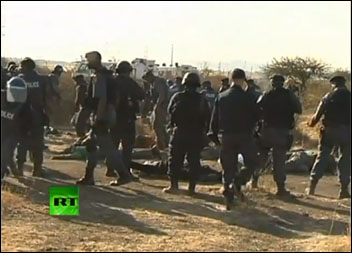Democratic Socialist Movement (DSM – CWI in South Africa) reporters

Mine workers hits the ground as firing starts – Russia Today video still, photo RT
In the face of widespread anger, the National Prosecuting Authority (NPA) has been forced to provisionally withdraw the murder charges against the 270 Lonmin platinum miners arrested after the 16 August Marikana massacre and to release them.
After repeated bail hearing postponements, lawyers representing the arrested mineworkers had issued an ultimatum to president Jacob Zuma to release the mineworkers by Sunday 2 September or face high court action. 170 miners were released. The NPA had already decided to lay charges of public violence, possession of dangerous weapons, possession of arms and ammunition as well as for an illegal gathering.
The murder and attempted murder charges were the fuse that detonated a volcano of rage across the country producing splits within the ruling African National Congress (ANC) itself.
Apart from the legal absurdity of the charges, what has further inflamed anger is the fact that the doctrine of ‘common purpose’ is the same legal weapon the apartheid regime used against the anti-apartheid struggle.
So outrageous was this decision to charge the survivors with the murder of those mowed down by the police live on television that even the leadership of the Cosatu trade union federation (whose reaction to the massacre had hitherto been a cowardly adaptation to the pressure from the discredited National Union of Mineworkers’ attempt to save face), was obliged to condemn the decision.
That such a decision could even have been contemplated is an indication of just how far to the right the ANC government has been driven under Zuma and his predecessors.
Collaboration

Police open fire on South African miners, dozens killed , RT video still
The NPA’s action comes barely weeks after it removed a prosecutor who resisted pressure to drop corruption charges against two leading ANC figures in Kwa Zulu Natal – the heartland of Zuma support. The NPA in fact has no head – Zuma appointee, Menzi Simelane, having been removed after the Supreme Court of Appeals found that he was not “fit and proper” to lead the NPA and that therefore his appointment was unconstitutional.
In concert with a senior police official who stated that none of the arrested workers would ever be allowed to work at Lonmin again, the NPA action demonstrates the extent to which institutions of state under the ANC have acted as the private security agencies of the mining bosses – exposing the role of the state machine under capitalism.
Even more shocking is the mounting evidence of what had been clear from the onset: that the massacre was premeditated. The poisonous propaganda that the police fired at the workers in self-defence is beginning to dissipate as reports indicate that many of the workers were shot in the back as they were fleeing.
Premeditated
Everything about the conduct of the Lonmin management, the government and the National Union of Mineworkers (NUM – whose leadership is part of the Zuma faction of the ANC), itself suggests that a decision to drown the strike in blood had been taken at the highest level of government, the police and Lonmin management.
The workers had armed themselves and retreated to Wonderkop, located several hundred metres away from the mine itself, not as an act of aggression but of self-defence following the killings in the mines that had already claimed ten lives as mine management security and the NUM collaborated in an attempt to break a strike which had been called independently by the workers.
Workers told the DSM that the strike had been led by an independent committee formed by the workers themselves following the NUM’s refusal to support the workers’ demands. This is confirmed by the stance taken by NUM general secretary Frans Baleni who earns R100,000 (£7,500) a month, denouncing the R12,500 a month demand by the workers as ‘unreasonable’.
The workers told the DSM that when they approached the NUM office at the mine to discuss united action, the delegation was shot at, killing two members of the committee. The mine management has a long bloody history of brutality towards workers in the mines that have the impertinence to try and break the chains of their oppression and exploitation. This was the basis for the decision to occupy the Wonderkop Hill.
The fact that the state deployed the South African Police Service Tactical Response Team armed with automatic R1 rifles, several armoured vehicles and razor wire indicates clearly that the massacre was premeditated.
The ANC’s reaction to these events is a study of incomprehension and callous indifference. It has yet to issue a statement condemning the massacre. Newly appointed Police Commissioner, general Riah Phiyega told the police after the massacre that the “safety of the public is non-negotiable. Don’t be sorry over what happened.”
For a full 48 hours not a single ANC leader set foot in the area. Even when Zuma announced the setting up of the Commission of Inquiry, he made it clear he will not apportion blame – this from a president portrayed as the voice of the poor leading a party that claims rather clumsily to have a “working class bias” and that strives to be a “disciplined force of the left”.
Imploding
The ANC is already bleeding, damaged by the deepening economic crisis, deep inequalities, the accumulating social problems of mass unemployment, crime, corruption, and the extreme embarrassment of not being able to deliver textbooks to state schools in several provinces more than three-quarters into the school year, and aggravated by faction fighting as the succession battle for the presidency leads to the ANC’s implosion.
The insult of the ‘common purpose’ charges, in spite of being dropped, has added to the deep political injury the ANC has suffered at Marikana which claimed the real lives of the over 34 workers but resulted in the ANC dying just a little more as well.
Now into its fourth week, the Lonmin workers are standing firm in the face of enormous pressure to return to work. The Ministers of Labour, Minerals and Energy, the Commission for Conciliation Mediation and Arbitration and the SA Council of Churches are all involved in trying to persuade parties to sign a ‘peace accord’. Amcu (the independent union that split from the NUM) has rejected this saying they are not at war with the NUM. They want negotiations on the workers’ demands to be the focus of mediation efforts.
In the meantime, inspired by the resistance of the Marikana miners, the platinum mine revolt has shifted to the gold sector, with 12,500 mine workers at Gold Field’s Kloof Driefontein complex downing tools illegally on Wednesday, 29 August. (Subsequent to this article security guards have wounded, with rubber bullets, four striking gold miners at Gold One’s flagship Modder East mine.)
These events pose a challenge to the organised working class as well. Cosatu’s silence before the Marikana massacre, induced by a reluctance to denounce the reactionary role played by its biggest affiliate, the NUM, merely served to embolden management.
Had Cosatu come out in support of the workers’ demands before the event, and prepared to mobilise solidarity action, the Lonmin management and the police wouldn’t have dared to act in the savage manner they did. Cosatu’s weakness invited the aggression of the bosses, the government and the state.
A line in the sand has been drawn by the bloodied bones of the martyrs of Marikana. Beyond this lies the disintegration of the ANC and the tripartite alliance (ANC, Coasatu, South African Communist Party) on the one hand, and the enormous possibilities for the growth of socialist ideas and for support for the establishment of a mass workers’ party on a socialist programme.







